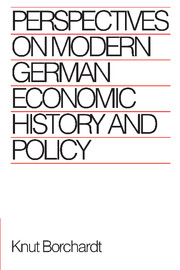Book contents
- Frontmatter
- Contents
- List of figures
- List of tables
- Preface to the English edition
- Preface to the German edition
- List of original chapter titles and first places of publication
- Abbreviations
- 1 Protectionism in historical perspective
- 2 Was there a capital shortage in the first half of the nineteenth century in Germany?
- 3 Regional variations in growth in Germany in the nineteenth century with particular reference to the west—east developmental gradient
- 4 Investment in education and instruction in the nineteenth century
- 5 Changes in the phenomenon of the business cycle over the last hundred years
- 6 Trends, cycles, structural breaks, chance: what determines twentieth-century German economic history?
- 7 The Federal Republic of Germany in the secular trend of economic development
- 8 Germany's experience of inflation
- 9 Constraints and room for manoeuvre in the great depression of the early thirties: towards a revision of the received historical picture
- 10 Economic causes of the collapse of the Weimar Republic
- 11 Germany's exchange rate options during the great depression
- Notes
- Index
7 - The Federal Republic of Germany in the secular trend of economic development
Published online by Cambridge University Press: 10 December 2009
- Frontmatter
- Contents
- List of figures
- List of tables
- Preface to the English edition
- Preface to the German edition
- List of original chapter titles and first places of publication
- Abbreviations
- 1 Protectionism in historical perspective
- 2 Was there a capital shortage in the first half of the nineteenth century in Germany?
- 3 Regional variations in growth in Germany in the nineteenth century with particular reference to the west—east developmental gradient
- 4 Investment in education and instruction in the nineteenth century
- 5 Changes in the phenomenon of the business cycle over the last hundred years
- 6 Trends, cycles, structural breaks, chance: what determines twentieth-century German economic history?
- 7 The Federal Republic of Germany in the secular trend of economic development
- 8 Germany's experience of inflation
- 9 Constraints and room for manoeuvre in the great depression of the early thirties: towards a revision of the received historical picture
- 10 Economic causes of the collapse of the Weimar Republic
- 11 Germany's exchange rate options during the great depression
- Notes
- Index
Summary
Diagnosis of an unparalleled process
Never before in German economic history have there been twenty-five years of such rapid economic development as after 1947/8. By economic development, we understand two aspects: first, the growth of real national product per capita; secondly, the change in economic structures, especially the structures of production and use of GNP. From 1950 to 1975 real national product per capita rose threefold in the Federal Republic. In the same period, to give two examples of structural change, the proportion of those engaged in agriculture fell from around 34 per cent to a mere 7 per cent, and the proportion of hard coal in primary energy consumption fell from over 70 per cent to around 20 per cent.
The circumstance that between 1950 and 1975 the economy produced no central conflict of political forces either at home or abroad must be considered highly exceptional in the long-term context. Indeed, it is possible to say, without offering specific proofs, that rapid economic development has contributed to the stability of the political order in the Federal Republic. The ‘economic miracle’ appears to be an important element in the de facto constitution of this part of divided Germany.
When the Federal Republic was founded, it was already felt that rapid growth might solve the politically explosive potentials for conflict in the post-war era (such as the refugee and expellee problem).
- Type
- Chapter
- Information
- Perspectives on Modern German Economic History and Policy , pp. 108 - 131Publisher: Cambridge University PressPrint publication year: 1991



